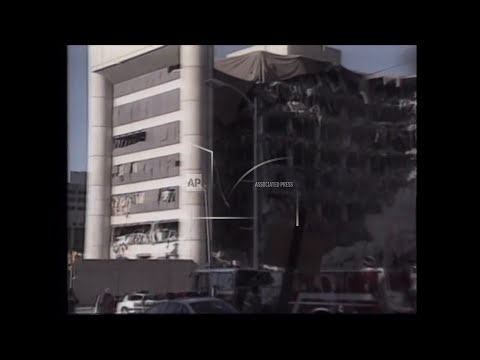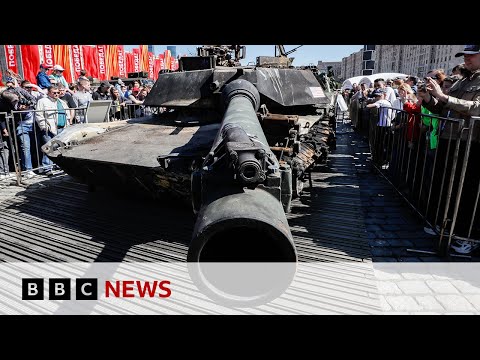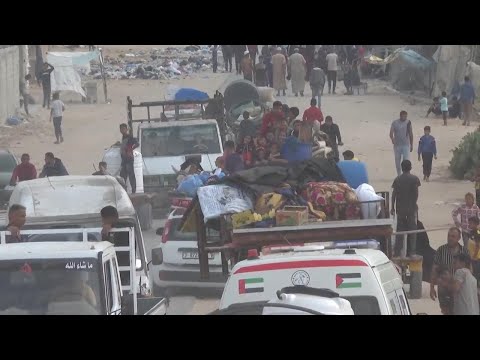(19 Apr 2025)
RESTRICTION SUMMARY:
ASSOCIATED PRESS
ARCHIVE: Oklahoma City, Oklahoma – 19 April 1995
1. Zoom out of the Alfred P. Murrah Federal Building exterior after explosion, debris, smoke rising
2. Various aerials of building, smoke rising
ASSOCIATED PRESS
ARCHIVE: Oklahoma City, Oklahoma – 20 April 1995
3. Various of building in rubble, search and rescue operations underway
ASSOCIATED PRESS
ARCHIVE: Exact date and location unknown
4. Timothy McVeigh and his lawyers ++MUTE++
5. Timothy McVeigh walking handcuffed, surrounded by police
ASSOCIATED PRESS
ARCHIVE: Oklahoma City, Oklahoma – 25 April 1995
6. Various of building in rubble
7. Various of firefighters on scene
ASSOCIATED PRESS
ARCHIVE: Oklahoma City, Oklahoma – 24 April 1995
8. Pan shot from makeshift memorial to building in rubble
9. Relatives of victims sitting on curb and waiting for news
STORYLINE:
Saturday is the 30th anniversary of the Oklahoma City bombing, the deadliest homegrown attack in United States history that exposed a dark undercurrent of anti-government extremist anger.
A bomb with a force powerful enough to instantly destroy much of a nine-story building shattered a quiet Oklahoma City morning and sent a shock wave through America.
The building that was bombed — the Alfred P. Murrah federal complex — included regional offices for several agencies, including the Social Security Administration, the FBI, the Secret Service, the Bureau of Alcohol, Tobacco and Firearms, and a credit union. America’s Kids Daycare was on the second floor.
The bomb, a mixture of ammonium nitrate and diesel fuel packed into a rental truck, sheared off about a third of the building and caused floors to collapse on each other. Some victims not killed by the blast were crushed to death, buried by the falling structure.
The dead ranged in age from three months to 73 years-old. Nineteen of them were children. Hundreds more were injured.
Authorities initially suspected the attack had been orchestrated by extremists outside the U.S., but the perpetrators turned out to be two former U.S. soldiers.
Timothy McVeigh and Terry Nichols met while serving in the Army. The pair held a deep anger toward the American government that had been sharpened by the 1993 federal raid on the Branch Davidian compound in Waco, Texas, that killed 76 people, and a standoff in the mountains of Ruby Ridge, Idaho, that left a 14-year-old boy, his mother and a federal agent dead.
The Oklahoma City bombing happened on the second anniversary of the fiery end to the 51-day Waco siege.
McVeigh drove the truck to the site and set the fuse to blow it up. He was convicted of 11 murder counts and executed by lethal injection in 2001.
Nichols helped McVeigh plan and build the bomb. He was convicted of conspiracy and involuntary manslaughter, and is serving life in prison.
A public ceremony Saturday to mark the anniversary at the Oklahoma City National Memorial Museum will include the reading of the names of the 168 people killed, remarks by victim family members and survivors, and a keynote address by former President Bill Clinton.
===========================================================
Clients are reminded to adhere to all listed restrictions and to check the terms of their licence agreements. For further assistance, please contact the AP Archive on: Tel +44(0)2074827482 Email: info@aparchive.com.
Find out more about AP Archive: http://www.aparchive.com/HowWeWork
Twitter: https://twitter.com/AP_Archive
Facebook: https://www.facebook.com/APArchives
Instagram: https://www.instagram.com/APNews/
You can license this story through AP Archive: http://www.aparchive.com/metadata/youtube/5cd62aaf8ff747f8b7387a44b94d611b
Author: AP Archive
Go to Source
News post in April 24, 2025, 3:04 am.
Visit Our Sponsor’s:
News Post In – News





